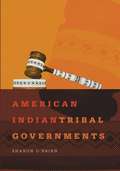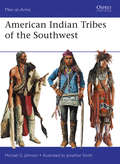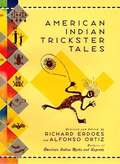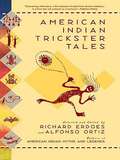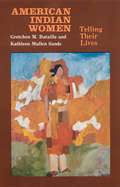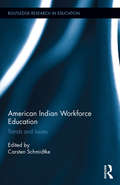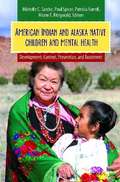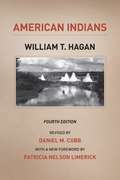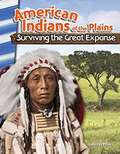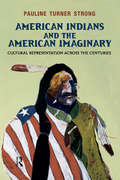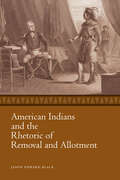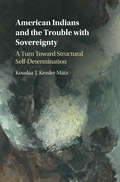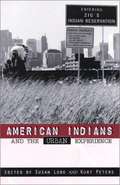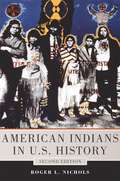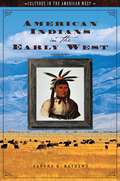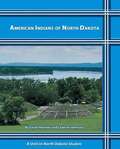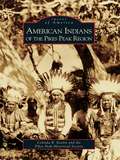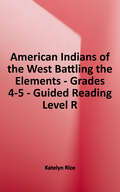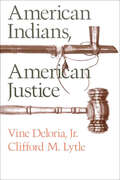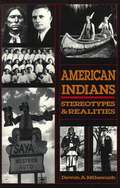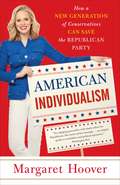- Table View
- List View
American Indian Tribal Governments
by Sharon O'BrienThis book describes the struggle of Indian tribes and their governments to achieve freedom and self-determination despite repeated attempts by foreign governments to dominate, exterminate, or assimilate them. Drawing on the disciplines of political science, history, law, and anthropology and written in a direct, readable style, American Indian Tribal Governments is a comprehensive introduction to traditional tribal governments, to the history of Indian-white relations, to the structure and legal rights of modern tribal governments, and to the changing roles of federal and state governments in relation to modem tribal governments. Publication of this book fills a gap in American Indian studies, providing scholars with a basis from which to begin an integrated study of tribal government, providing teachers with an excellent introductory textbook, and providing general readers with an accessible and complete introduction to American Indian history and government. The book's unique structure allows coverage of a great breadth of information while avoiding the common mistake of generalizing about all tribes and cultures. An introductory section presents the basic themes of the book and describes the traditional governments of five tribes chosen for their geographic and cultural diversity-the Senecas, the Muscogees, the Lakotas, the Isleta Pueblo, and the Yakimas. The next three chapters review the history of Indian-white relations from the time Christopher Columbus "discovered" America to the present. Then the history and modem government of each of the five tribes presented earlier is examined in detail. The final chapters analyze the evolution and current legal powers of tribal governments, the tribal-federal relationship, and the tribal-state relationship. American Indian Tribal Governments illuminates issues of tribal sovereignty and shows how tribes are protecting and expanding their control of tribal membership, legal systems, child welfare, land and resource use, hunting and fishing, business regulation, education, and social services. Other examples show tribes negotiating with state and federal governments to alleviate sources of conflict, including issues of criminal and civil jurisdiction, taxation, hunting and fishing rights, and control of natural resources. Excerpts from historical and modem documents and speeches highlight the text, and more than one hundred photos, maps, and charts show tribal life, government, and interaction with white society as it was and is. Included as well are a glossary and a chronology of important events.
American Indian Tribes of the Southwest
by Michael Johnson Jonathan SmithThis book continues Osprey's series of Men-at-Arms titles on the history, costume, and material culture of the native peoples of North America, which is organized into geographical regions, language groups, and tribes. It was in the Southwest - modern Arizona, New Mexico, and parts of California and other neighboring states - that the first major clashes took place between 16th-century Spanish conquistadors and the indigenous peoples of North America. This uniquely long history of contact, conflict, and coexistence with first the Spanish, then their Mexican settlers, and finally the Americans, gives a special flavor to the region. So too does the wide cultural diversity of the peoples who inhabited the challenging environment of the Southwest - from the quasi-Plains culture of the Kiowa-Apache and Lipan, to the pueblo cave-villages of the agricultural Zuni and Hopi. (Indeed, from c. 1700 to 1848 the Pueblo villagers often allied themselves with Spanish and Mexican settlers against the encroachments of Apache and Navajo hunters and raiders.) Despite nearly 500 years of white settlement and pressure, the traditional cultures of the peoples of the Southwest survive today more strongly than in any other region, and with them a sense of separate identity. The best-known clashes between the whites and the Indians of this region are the series of Apache wars, particularly between the early 1860s and the late 1880s. However, there were other important regional campaigns over the centuries - for example, Coronado's battle against the Zuni at Hawikuh in 1540, during his search for the legendary "Seven Cities of Cibola"; the Pueblo Revolt of 1680; and the Taos Revolt of 1847 - and warriors of all of these are described and illustrated in this book. War was inseparable in the local cultures from religious beliefs, such as the veneration of the mothers of war gods - White Painted Woman among the Apache, and Changing Woman among the Navajo; the plates in this book illustrate the rites associated with such figures, and several other important ritual observances. The variety of costumes illustrated, from the earliest times up to today, make these plates especially rich.
American Indian Trickster Tales
by Richard Erdoes Alfonso Ortizit's the Trickster who provides the real spark in the action
American Indian Trickster Tales
by Richard ErdoesOf all the characters in myths and legends told around the world, it's the wily trickster who provides the real spark in the action, causing trouble wherever he goes. This figure shows up time and again in Native American folklore, where he takes many forms, from the irascible Coyote of the Southwest, to Iktomi, the amorphous spider man of the Lakota tribe. This dazzling collection of American Indian trickster tales, compiled by an eminent anthropologist and a master storyteller, serves as the perfect companion to their previous masterwork, American Indian Myths and Legends. American Indian Trickster Tales includes more than one hundred stories from sixty tribes? many recorded from living storytellers?which are illustrated with lively and evocative drawings. These entertaining tales can be read aloud and enjoyed by readers of any age, and will entrance folklorists, anthropologists, lovers of Native American literature, and fans of both Joseph Campbell and the Brothers Grimm. .
American Indian Women: Telling Their Lives
by Gretchen M. Bataille Kathleen Mullen SandsIndian women's autobiographies have been slighted because of the assumption that women had a secondary and insignificant role in Indian society. Gretchen M. Bataille and Kathleen Mullen Sands cogently demonstrate in this book the creative vitality of autobiographies that, despite differences in style and purpose, clarify the centrality of women in American Indian cultures. Included is a comprehensive, annotated bibliography or works by and about American Indian women.
American Indian Workforce Education: Trends and Issues (Routledge Research in Education #163)
by Carsten SchmidtkeIn this collection of original essays, contributors critically examine the pedagogical, administrative, financial, economic, and cultural contexts of American Indian vocational education and workforce development, identifying trends and issues for future research in the fields of vocational education, workforce development, and American Indian studies.
American Indian and Alaska Native Children and Mental Health: Development, Context, Prevention, and Treatment
by Paul Spicer Michelle C. Sarche Patricia Farrell Hiram E. FitzgeraldThis book examines the physical, psychological, social, and environmental factors that support or undermine healthy development in American Indian children, including economics, biology, and public policies.
American Indians
by William T. HaganWilliam Hagan’s classic American Indians has become standard reading in the field of Native American history. Daniel M. Cobb has taken over the task of updating and revising the material, allowing the book to respond to the times. Spanning the arrival of white settlers in the Americas through the twentieth century, this concise account includes more than twenty new maps and illustrations, as well as a bibliographic essay that surveys the most recent research in Indian-white relations. With an introduction by Cobb, and a foreword by eminent historian Patricia Nelson Limerick, this fourth edition marks the fiftieth anniversary of the original publication of American Indians.
American Indians Of The Plains: Surviving The Great Expanse (Social Studies: Informational Text Series)
by Jennifer Overend PriorHighlight some of the fascinating aspects of life on the Plains with the American Indians of the Plains: Surviving the Great Expanse e-Book. Students will explore different facets of Plains culture, including the importance of buffalo in everyday life – as their source of food, clothing, homes, weapons, and many other things. This informational text takes a look at some of the distinctive features of the Lakota, Cheyenne, Comanche, Pawnee, Osage, Omaha, and Crow tribes. Ignite a curiosity with this nonfiction reader that breathes life into the pages of history with real-life artifacts from that era. Build literacy and subject content knowledge with this rigorous, high-interest reader that explores US history, geography, and other social studies topics. The American Indians of the Plains: Surviving the Great Expanse e-Book provides access to every type of learner with appropriately leveled content. The e-Book contains text features such as captions, bold print, glossary, and index to increase understanding and build academic vocabulary. Aligned to McREL, WIDA/TESOL, NCSS/C3 Framework and other state standards, this text readies students for college and career readiness.
American Indians and the American Dream: Policies, Place, and Property in Minnesota
by Kasey R. KeelerUnderstanding the processes and policies of urbanization and suburbanization in American Indian communities Nearly seven out of ten American Indians live in urban areas, yet studies of urban Indian experiences remain scant. Studies of suburban Natives are even more rare. Today&’s suburban Natives, the fastest-growing American Indian demographic, highlight the tensions within federal policies working in tandem to move and house differing groups of people in very different residential locations. In American Indians and the American Dream, Kasey R. Keeler examines the long history of urbanization and suburbanization of Indian communities in Minnesota.At the intersection of federal Indian policy and federal housing policy, American Indians and the American Dream analyzes the dispossession of Indian land, property rights, and patterns of home ownership through programs and policies that sought to move communities away from their traditional homelands to reservations and, later, to urban and suburban areas. Keeler begins this analysis with the Homestead Act of 1862, then shifts to the Indian Reorganization Act in the early twentieth century, the creation of Little Earth in Minneapolis, and Indian homeownership during the housing bubble of the early 2000s.American Indians and the American Dream investigates the ways American Indians accessed homeownership, working with and against federal policy, underscoring American Indian peoples&’ unequal and exclusionary access to the way of life known as the American dream. Cover alt text: Vintage photo of Native person bathing smiling child in the sink of a midcentury kitchen. Title in yellow.
American Indians and the American Imaginary: Cultural Representation Across the Centuries
by Pauline Turner StrongAmerican Indians and the American Imaginary considers the power of representations of Native Americans in American public culture. The book's wide-ranging case studies move from colonial captivity narratives to modern film, from the camp fire to the sports arena, from legal and scholarly texts to tribally-controlled museums and cultural centres. The author's ethnographic approach to what she calls "representational practices" focus on the emergence, use, and transformation of representations in the course of social life. Central themes include identity and otherness, indigenous cultural politics, and cultural memory, property, performance, citizenship and transformation. American Indians and the American Imaginary will interest general readers as well as scholars and students in anthropology, history, literature, education, cultural studies, gender studies, American Studies, and Native American and Indigenous Studies. It is essential reading for those interested in the processes through which national, tribal, and indigenous identities have been imagined, contested, and refigured.
American Indians and the Law
by N. Bruce DuthuA perfect introduction to a vital subject very few Americans understand-the constitutional status of American Indians Few American s know that Indian tribes have a legal status unique among America's distinct racial and ethnic groups: they are sovereign governments who engage in relations with Congress. This peculiar arrangement has led to frequent legal and political disputes-indeed, the history of American Indians and American law has been one of clashing values and sometimes uneasy compromise. In this clear-sighted account, American Indian scholar N. Bruce Duthu explains the landmark cases in Indian law of the past two centuries. Exploring subjects as diverse as jurisdictional authority, control of environmental resources, and the regulations that allow the operation of gambling casinos, American Indians and the Law gives us an accessible entry point into a vital facet of Indian history. .
American Indians and the Rhetoric of Removal and Allotment (Race, Rhetoric, and Media Series)
by Jason Edward BlackJason Edward Black examines the ways the US government’s rhetoric and American Indian responses contributed to the policies of Native–US relations throughout the nineteenth century’s removal and allotment eras. Black shows how these discourses together constructed the perception of the US government and of American Indian communities. Such interactions—though certainly not equal—illustrated the hybrid nature of Native–US rhetoric in the nineteenth century. Both governmental, colonizing discourse and indigenous, decolonizing discourse shaped arguments, constructions of identity, and rhetoric in the colonial relationship.American Indians and the Rhetoric of Removal and Allotment demonstrates how American Indians decolonized dominant rhetoric through impeding removal and allotment policies. By turning around the US government’s narrative and inventing their own tactics, American Indian communities helped restyle their own identities as well as the government’s. During the first third of the twentieth century, American Indians lobbied for the successful passage of the Indian Citizenship Act of 1924 and the Indian New Deal of 1934, changing the relationship once again.In the end, Native communities were granted increased rhetorical power through decolonization, though the US government retained an undeniable colonial influence through its territorial management of Natives. The Indian Citizenship Act and the Indian New Deal—as the conclusion of this book indicates—are emblematic of the prevalence of the duality of US citizenship that fused American Indians to the nation yet segregated them on reservations. This duality of inclusion and exclusion grew incrementally and persists now, as a lasting effect of nineteenth-century Native–US rhetorical relations.
American Indians and the Trouble with Sovereignty: A Turn Toward Structural Self-Determination
by Kessler-Mata Kouslaa T.With tribes and individual Indians increasingly participating in American electoral politics, this study examines the ways in which tribes work together with state and local governments to overcome significant governance challenges. Much scholarship on tribal governance continues to rely on a concept of tribal sovereignty that does not allow for or help structure this type of governance activity. The resulting tension which emerges in both theory and practice from American Indian intergovernmental affairs is illuminated here and the limits of existing theory are confronted. Kessler-Mata presents an argument for tribal sovereignty to be normatively understood and pragmatically pursued through efforts aimed at interdependence, not autonomy. By turning toward theories of federalism and freedom in the republican tradition, the author provides an alternative framework for thinking about the goals and aspirations of tribal self-determination.
American Indians and the Urban Experience
by Susan Lobo Kurt PetersThis is a collection of essays describing the Native Americans' experiences beyond the reservation.
American Indians in U.S. History (Second Edition)
by Roger L. NicholsThe author traces tribal experiences through four eras: Indian America prior to the European invasions; the colonial period; the emergence of the United States as the dominant power in North America and its subsequent invasion of Indian lands; and the years from 1900 to the present. Nichols uses both Euro-American sources and tribal stories to illuminate the problems Indian people and their leaders have dealt with in every generation.
American Indians in the Early West (Cultures in the American West)
by Sandra K. MathewsMathews (history, U. of New Mexico) offers an alternative view to histories that concentrate on the violent and often tragic confrontations between native Americans and Anglo-Americans in the 19th century. Instead, she concentrates on the clashes between the Indian nations and colonizers that began almost 300 years before the United States was born. Topics include the origins, migrations and geographical location of the earlier native Americans, the history of the Spanish in the southwest, the history of the French from the Saint Lawrence and Great Lakes to the Rocky Mountains and Russian involvement from the Aleutian Chain to Northern California. The book also addresses major issues in the study of American Indian history. Annotation ©2008 Book News, Inc., Portland, OR (booknews.com)
American Indians of North Dakota (North Dakota Studies)
by Gwyn S. Herman Laverne A. JohnsonThis book is filled with interesting history, impressive facts, and inspiring profiles. Through reading and engaging in the variety of activities that accompany this text, you will find yourself on a dynamic and educational journey of discovery.
American Indians of the Pikes Peak Region
by Pikes Peak Historical Society Celinda R. KaelinThousands of years before Zebulon Pike's name became attached to this famous mountain, Pikes Peak was home to indigenous people. These First Nations left no written record of their sojourn here, but what they did leave were stone circles, carefully crafted arrowheads and stone tools, enigmatic petroglyphs, and culturally scarred trees. In the 1500s, Spanish explorers documented their locations, language, and numbers. In the 1800s, mountain men and official explorers such as Pike, Fremont, and Long also wrote about these First Nations. Comanche, Apache, Arapaho, Cheyenne, Kiowa, and Lakota made incursions into the region. These nations contested Ute land possession, harvested the abundant wildlife, and paid homage to the powerful spirits at Garden of the Gods and Manitou Springs. Today Ute Indians return to Garden of the Gods and to Pikes Peak each year to perform their sacred Sundance Ceremony.
American Indians of the West: Battling the Elements (Social Studies: Informational Text Ser.)
by Katelyn RiceThe Primary Source Readers series will ignite students' interest in history through the use of intriguing primary sources. This nonfiction reader features purposefully leveled text to increase comprehension for different learner types. Students will learn about American Indians of the West including tribes of the Pacific Northwest, Southwest, Great Basin, and Plateau. Text features include captions, a glossary, and an index to help build academic vocabulary and increase reading comprehension and literacy. This book prepares students for college and career readiness and aligns with state standards including NCSS/C3, McREL, and WIDA/TESOL.
American Indians, American Justice
by Clifford M. Lytle Deloria VineThis comprehensive overview of federal Indian law explores the context and complexities of modern Native American politics and legal rights.Both accessible and authoritative, American Indians, American Justice is an essential sourcebook for all concerned with the plight of the contemporary Indian. Beginning with an examination of the historical relationship of Indians and the courts, the authors describe how tribal courts developed and operate today, and how they relate to federal and state governments. They also define such key legal concepts as tribal sovereignty and Indian Country. By comparing and contrasting the workings of Indian and non-Indian legal institutions, the authors illustrate how Indian tribes have adapted their customs, values, and institutions to the demands of the modern world. They examine how attorneys and Indian advocates defend Indian rights; identify the typical challenges Indians face in the criminal and civil legal arenas; and explore the public policy and legal rights of Indians as regards citizenship, voting rights, religious freedom, and basic governmental services.
American Indians, American Justice
by Vine Deloria Jr. Clifford M. LytleBaffled by the stereotypes presented by Hollywood and much historical fiction, many other Americans find the contemporary American Indian an enigma. Compounding their confusion is the highly publicized struggle of the contemporary Indian for self-determination, lost land, cultural preservation, and fundamental human rights-a struggle dramatized both by public acts of protest and by precedent-setting legal actions. More and more, the battles of American Indians are fought-and won-in the political arena and the courts. American Indians, American Justice explores the complexities of the present Indian situation, particularly with regard to legal and political rights. It is the first book to present an overview of federal Indian law in language readably accessible to the layperson. Remarkably comprehensive, it is destined to become a standard sourcebook for all concerned with the plight of the contemporary Indian. Beginning with an examination of the historical relationship of Indians and the courts, the authors describe how tribal courts developed and operate today, and how they relate to federal and state governments. They define such key legal concepts as tribal sovereignty and Indian Country. By comparing and contrasting the workings of Indian and non-Indian legal institutions, the authors illustrate how Indian tribes have adapted their customs, values, and institutions to the demands of the modern world. Describing the activities of attorneys and Indian advocates in asserting and defending Indian rights, they identify the difficulties typically faced by Indians in the criminal and civil legal arenas and explore the public policy and legal rights of Indians as regards citizenship, voting rights, religious freedom, and basic governmental services.
American Indians: Stereotypes and Realities
by Devon A. MihesuahAmerican Indians are portrayed in many ways, but often the portraits reflect more myth than reality. "This book is not intended to chronicle the history of any tribe or to analyze its culture, nor to detail intricacies of American Indian tribal politics, law, or economics. It is not intended to glorify Indians nor to criticize those people who believe the myths. Its purpose is to stimulate dialogue and to correct some of the most prevalent misconceptions about Indians. There are more, no doubt. But it is my hope that this bookwill spur teachers to fight for better textbooks-books that include a complete history of this country -and to push for multicultural curriculums. It is important for all of us to recognize and to combat stereotypes. All peoples deserve to have their histories and cultures properly placed in the scheme of things. Anything less does us all a disservice." Mihesuah includes a generous number of recommended readings.
American Individualism
by George H. Nash Herbert HooverIn late 1921, then secretary of commerce Herbert Hoover decided to distill from his experiences a coherent understanding of the American experiment he cherished. The result was the 1922 book American Individualism. In it, Hoover expounded and vigorously defended what has come to be called American exceptionalism: the set of beliefs and values that still makes America unique. He argued that America can make steady, sure progress if we preserve our individualism, preserve and stimulate the initiative of our people, insist on and maintain the safeguards to equality of opportunity, and honor service as a part of our national character. American Individualism asserts that equal opportunity for individuals to develop their abilities is "the sole source of progress" and the fundamental impulse behind American civilization for three—now four—centuries. More than ninety years have passed since this book was first published; it is clear, in retrospect, that the volume was partly motivated by the political controversies of the time. But American Individualism is not simply a product of a dim and receding past. To a considerable degree the ideological battles of Hoover's era are the battles of our own, and the interpretations we make of our past—particularly the years between 1921 and 1933—will mold our perspective on the crises of the present.
American Individualism: How a New Generation of Conservatives Can Save the Republican Party
by Margaret HooverMargaret Hoover has been a lifelong member of the Republican Party. She grew up a self-described "ditto head." She worked in the White House for President George W. Bush. Today she is a political commentator for Fox News, where, as one of Bill O'Reilly's Culture Warriors, she regularly champions the conservative cause. She also happens to be the great-granddaughter of the thirty-first president of the United States, Herbert Hoover. These impeccable conservative credentials underscore the gravity of her deep-seated concerns about the future of the Republican Party. Her party, she believes, has fallen dangerously out of step with the rising generation of young Americans. In American Individualism, Margaret Hoover chal-lenges the up-and-coming millennial generation to take another look at the Republican Party. Although millennials rarely identify themselves as Republicans, Hoover contends that these young men and women who helped elect President Barack Obama are sympathetic to the fundamental principles of conservatism. She makes a compelling case for how the GOP can right itself and capture the allegiance of this group. She believes that her party is uniquely positioned to offer solutions for the most pressing problems facing America--skyrocketing debt and deficits, crises in education and immigration, a war against Islamist supremacy--but that it is held back by the outsize influence within the party of social and religious conservatives. American Individualism is Hoover's call to action for Republicans to embrace a conservatism that emphasizes individual freedom both in economic policy and in the realm of social issues in order to appeal to the new generation of voters. The Republican Party, Hoover asserts, can win the support of the millennials while at the same time remaining faithful to conservative principles. In a journey that is both political and personal, Hoover rediscovers these bedrock conservative values in the writings of her great-grandfather, President Herbert Hoover, who emphasized the vital importance of individual freedom to the American way of life and who sought to strike a delicate balance in identifying the limited yet essential role the federal government should play in the lives of Americans. Margaret Hoover advocates a conservatism that is fully consistent with the original impulses of the American conservative movement. It evokes her great-grandfather's emphasis on the values of civic responsibility and service to others--instincts instilled in the millennial generation. She argues that the Republican Party today must evolve in order to achieve greatness, and that it can do so without compromising its tried-and-true fundamental principles. On the contrary, those enduring principles, if consistently applied, will enable the party to attract a younger following. An impassioned and persuasive political manifesto grounded in twentieth-century history and targeted at the most perplexing problems of the twenty-first century, Margaret Hoover's American Individualism offers provocative ideas not just for reinvigorating the Republican Party but also for strengthening America in the decades ahead.Praise for American Individualism:"It is not her great grandfather's Republican party anymore. And Margaret Hoover has written a book that old Herbert would enjoy. Sassy, opinionated, and smart, Ms. Hoover shakes up conventional GOP wisdom." --Bill O'Reilly, Anchor, Fox News Channel "Margaret Hoover, a fresh and brilliant young voice in the Republican Party, is bent on connecting the GOP to rising generations of the young. She has something to say to their elders, too. They'd best hear her." --Peggy Noonan, columnist, Wall Street Journal"Margaret Hoover's American Individualism is a must read for every member of the Republican party--elected or otherwise--as a new generation of Republicans try to shine new light on who exactly we should be." --Meghan McCain, author of Dirty Sexy PoliticsFrom the Hardcover edition.
